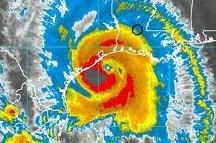News & Events
University Communication
Faculty Experts

UH Offers Experts on Hurricanes
Representing experts across various fields, University of Houston sources have expertise in an array of topics related to storms – before, during and after.
Fighting Obesity may be as easy as ATP, says UH researcher NIH, NSF funds biosensors that would track metabolic activity, diagnose unhealthy conditions
Physics Professor John Miller, director of the High-Temperature Superconducting Device Applications and Nano-Biophysics Laboratory in the Texas Center for Superconductivity at the University of Houston (TcSUH), recently received a three-year, $623,425 exploratory research grant from the National Institutes of Health (NIH) in a joint program with the National Science Foundation (NSF) on biosensors for energy balance and obesity.
In particular, Miller is targeting metabolic syndrome, a pernicious complication of obesity that affects about 20 percent of obese individuals and greatly increases the likelihood of diabetes, heart disease and cancer. His long-term goal is to develop innovative technologies that detect metabolic activity for research and clinical applications.
“Although drug treatments for metabolic syndrome exist, the cost of drugs to treat all obese individuals is prohibitive,” Miller said. “Therefore, there is a critical public health need to develop technologies that can provide early diagnosis of metabolic syndrome and enable cost-effective treatment, as well as to measure metabolic activity and other components of energy balance in obese patients.”
The chemical currency of energy and metabolism that is used by the cellular machinery of all living organisms is adenosine triphosphate (ATP) – a molecule involved in more chemical reactions than any other on Earth except water. In animals, plants and fungi, ATP is produced by enzyme complexes in mitochondria that live and reproduce inside the cell. ATP molecules can be thought of as packets of “fuel” that power biological molecular motors. If one were to suddenly run out of ATP, death would be instantaneous. However, ATP that goes unused eventually gets converted into fat – hence the growing obesity epidemic at a time when high-calorie food is plentiful.
The focus of the NIH grant is to develop sensors, based on harmonic generation spectroscopy and related techniques, that detect metabolic activity in mitochondrial complexes. Often considered the powerhouses of cells, mitochondria convert molecules extracted from the food we eat into ATP, the fuel used by the rest of the cell. The mitochondria house enzymes that carry out these steps essential to metabolism.
The NIH-funded project will focus on electrode-based sensors that detect mitochondrial enzymes in action and may lead to development of portable instruments worn by patients for continuous monitoring of resting and active metabolism, as well as other clinical devices. Moreover, studies have shown that mitochondria are often defective in patients suffering from obesity, type-2 diabetes and heart disease. It is hoped the sensors will be able to distinguish normal from dysfunctional mitochondrial activity.
Miller’s collaborators include William Widger, professor of biology and biochemistry at UH; and Drs. Dale Hamilton and Richard Robbins, endocrinologists in the Department of Medicine at The Methodist Hospital. The NIH award will last through Aug. 31, 2010.
In addition to the NIH project, Miller is focusing on a related project that is part of the TcSUH Biomedical Research Program and is being funded by TcSUH. It focuses more on technologies based on superconducting quantum interference devices (SQUIDs) and related magnetic sensors that measure minute changes in magnetic flux used to detect extremely small changes in magnetic fields, electric currents and voltages. This could lead to clinical instruments designed for early diagnosis of metabolic syndrome and insulin resistance.
Miller envisions that nanoscale probes eventually could be developed to image activity of individual biological molecular motors that produce ATP, such as the molecular turbine ATP synthase, which is the smallest known rotary motor in existence that produces ATP with amazing efficiency. The human body contains about sextillion of these motors that recycle anywhere from a person’s own body weight to more than a ton of ATP in a single day, depending on how vigorously one exercises.
Joining UH in 1989 as a faculty member in the Department of Physics and TcSUH, Miller previously was a faculty member in the Department of Physics and Astronomy at the University of North Carolina - Chapel Hill from 1986-1989, receiving the prestigious Alfred P. Sloan Research Fellowship in 1987. He received his Ph.D. at the University of Illinois in 1985, where he studied the dynamics of charge density waves under the direction of John Tucker and two-time Nobel laureate John Bardeen.
About the University of Houston
The University of Houston, Texas’ premier metropolitan research and teaching institution, is home to more than 40 research centers and institutes and sponsors more than 300 partnerships with corporate, civic and governmental entities. UH, the most diverse research university in the country, stands at the forefront of education, research and service with more than 35,000 students.
About the Texas Center for Superconductivity at the University of Houston
TcSUH is internationally recognized for its multidisciplinary research and development of high-temperature superconductors (HTS), as well as energy- and nano-materials. With more than 200 faculty, postdoctoral fellows, and graduate and undergraduate students from the departments of chemistry, physics, chemical engineering, electrical and computer engineering, and mechanical engineering, TcSUH disseminates fundamental and applied knowledge through extensive education and outreach programs. For more information, visit www.tcsuh.uh.edu.
To receive UH science news via e-mail, visit www.uh.edu/admin/media/sciencelist.html.
For more information about UH visit the university’s ‘Newsroom’ at www.uh.edu/admin/media/newsroom.
